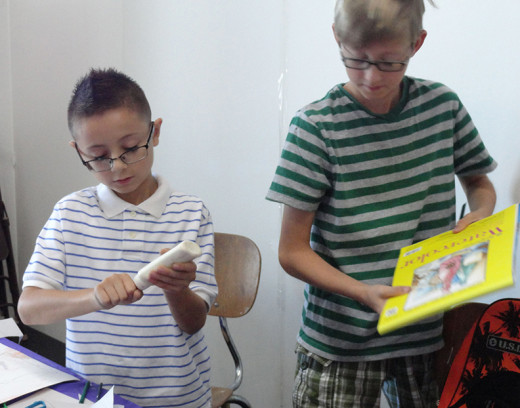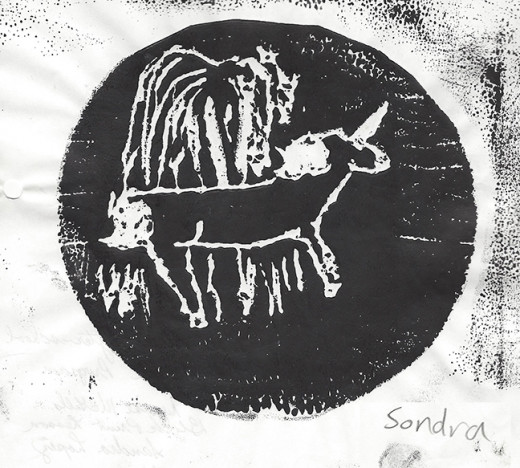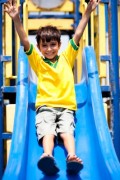Childhood Stages of Creative Growth and Self Expression

Childhood Development of Creativity, Stages 0 to 7 years
Children need creativity and outlets for self-expression to grow into healthy. Well-rounded adults. Studies done on children reveal that those exposed to and encouraged to experience different forms of creative expression at an early age will reflect more “mature” expressions of creative development. Creative development can exhibit itself in a number of ways; visual arts and painting, dance, drama and theater, music, and creative writing. Inspiring and promoting imagination and creative thought are so important to a child’s growth that it still amazes me when the arts are the first things cut in economic depressions.
The following are some of the findings of studies for the normal development of creative expression and grown in children. Keep in mind that those exposed to a number of artistic disciplines early will exhibit an advanced maturity in self-expression.
Scribble

The Disordered Stage, Scribbling, 2 to 4 years
This age expresses itself in lines formed by undirected movements, using no control of motor activity. Color is used for pure enjoyment and no real conscious approach is taken in choosing them.
Encourage activity by providing materials including large primary crayons and large smooth paper. Use dark colors so they are easily seen and enjoyed rather than the lighter yellows, which have to be pressed hard to get satisfying results. Occasionally provide finger paint and paper with supervision, of course, to add to the enjoyment of movement and color. Younger children are very tactile and love getting their hands into the colors.


Do you notice creative development in your children.
Longitudinal or Controlled Stage, Scribble, 2 to 4 years
This stage allows for more repetition of lines drawn consciously up and down or left and right. More motor skill and visual control are being employed at this stage and the child is gaining confidence in each experimented page. The colors and the organization are still at a disordered stage but are gaining in control and eye to hand coordination. Pure enjoyment is gained from the kinesthetic sensation, although no discernable realism is present. Do not discourage this activity and experimentation.
On top of the large crayons and finger paint from the previous stage, provide more outlets for this building of creativity, such as clay, play-dough, sand, water, blocks, Legos, tinker toys, etc. All of these provide sensory stimulation and encourage exploration, even if the child has no creative intentions at this stage.
Circular Scribble

Circular Stage, Scribble, 2 to 4 years
At this stage, the child is experimenting and developing more complex motions, specifically circular lines through the movement of the whole arm. This is still a disordered and unorganized movement but contains more development of certain motor skills.
Continue to encourage self-expression through providing a variety of materials and some supervision. Allow the creativity to flow and avoid saying “no, no,” or “do it like this.” Allow the child to reach his own conclusions and development.



Name of Scribbling Stage
This stage is the beginning of imaginative things and putting things together that tells stories and usually connects shapes to experiences. The child may scribble shapes they are calling mommy and daddy but which bear little resemblance. Colors are chosen more deliberately and add to the meanings of the scribbled story.
Ask the child questions, stimulating responses in the motions and expressions. Encourage imaginative thinking rather than drawing recognizable objects and shapes. Remember to praise the child often for their good ideas and expressions. Continue to provide opportunities for manipulations of clay and paper.
Materials at this stage include color crayons, paint, finger paint, easel, blackboard, and chalk or dry erase board and markers, clay, construction paper. You can add cutting, arranging and pasting of shapes to the list of materials already provided.
At just over two years old my oldest daughter toddled up to me with a piece of paper she had been drawing on. A large oval and six smaller ovals had been drawn on the paper. I asked what it was and she said, “turtle.” Sure enough, it was a turtle. I was amazed because I had no idea where she had seen a turtle before until I realized that my sister had embroidered a stylized turtle for her when she was a baby and it was in her crib during her first year. She remembered it and drew it. This is the naming stage where the child knows what they are trying to depict and can name it.




Preschematic Stage, 4 to 7 years
At this time the child is gaining in small motor skills, is probably able to write his name and possibly the alphabet. With each year and each experience the creative expression grows. The child converts scribbling into casual relationship of body movements. Representation of objects is becoming clearer and symbols are forming. The child is developing conscious creation and searching for new concepts through change in forms of symbols. Color still has a purely emotional appeal but is often used in relationship to known things, such as yellow for the sun and blue for the sky, although not always. This is where stick figures with lollypop heads develop to represent human form. Often in the beginning complex forms like hands and feet are left off or drawn as circles.
Stimulate expression by asking “where,” “when,” “what,” and “how” of the experiences drawn. Most drawing will be about the immediate family or the child’s most intimate circle of acquaintances. Encourage creative depiction of the child’s day or family activities. Provide materials such as crayon, chalk, tempera paint, finger paint, easel, large brushes, clay, felt markers, colored paper, paste, scissors, wood scraps, glue, fabric. Allow for drawing, painting, modeling, cut and torn paper and paste.





Finally
These are just guidelines for the development and encouragement of skills developed by children at different stages. Regular visits to museums and theaters, concerts and galleries help immensely in the further development and enrichment of children. I loved taking my children to the library and the few museums our town had to offer, and I loved seeing the displays as much or maybe more than they did. Since then, one of my daughters has gotten a degree in art and designs for a gaming company, my son has written 4 sci-fi/fantasy novels and is working on another. The two older daughters have gone into professions, one is an attorney and the other a nurse, but they are both creative with their families, sewing clothes and playing music at their church. I’m glad I exposed them all to as much creative expression as I could and hope they will do the same with their families.














